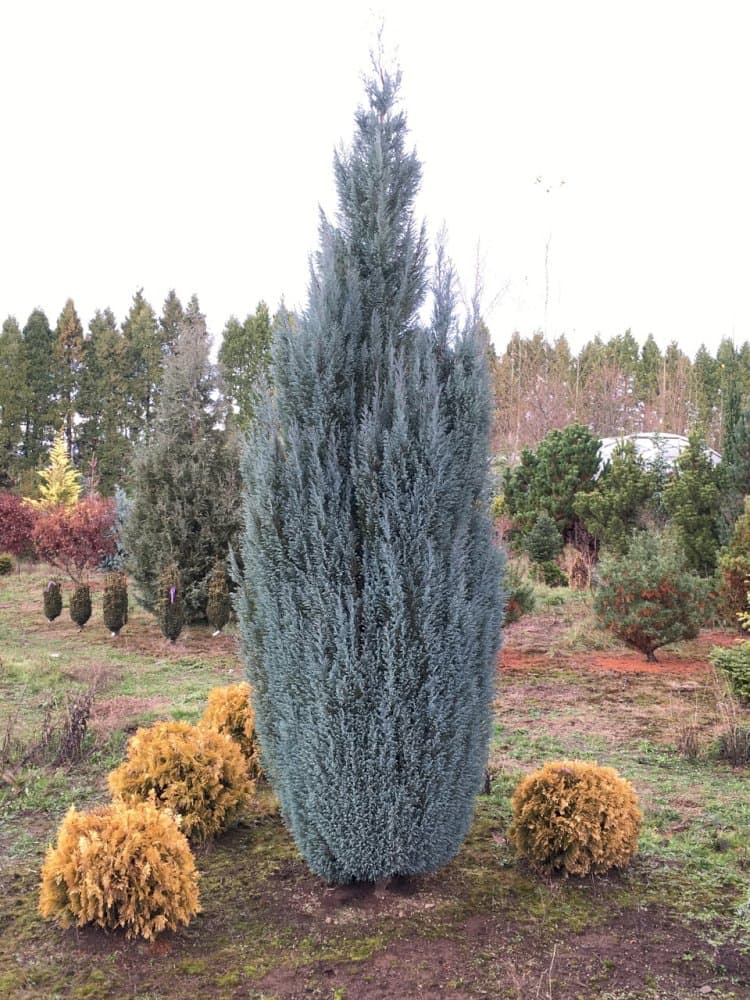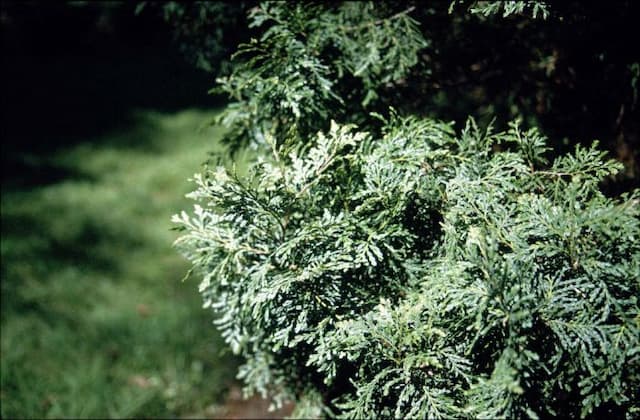Lawson's Cypress Chamaecyparis lawsoniana 'Lutea'











ABOUT
The plant commonly known as the Lawson's Cypress 'Lutea' features striking golden-yellow foliage that stands out in the landscape. Its needles are fine and soft to the touch, which creates a feathery appearance, transitioning from bright yellow on the outer tips when exposed to the sun, to a more muted, greenish-yellow shade deeper within the tree. The needles array themselves in a somewhat flattened, spray-like arrangement, adding to the plant's textural interest. It has a conical shape with dense, layered branches that can taper to a narrow point at the top. The bark of the Lawson's Cypress 'Lutea' adds to the ornamental value of the plant, with a reddish-brown color that can sometimes show through the foliage, peeling off in vertical strips. Cones may also be present on the tree, small and brown, they are not typically a prominent feature, blending in amongst the foliage. This variety of cypress is commonly admired for its bright coloration and is often used as a specimen in gardens for its year-round attractiveness.
About this plant
 Names
NamesFamily
Cupressaceae.
Synonyms
Lawson's Cypress, Port Orford Cedar, Yellow Cedar, Oregon Cedar, Ginger Pine.
Common names
Cupressus lawsoniana 'Lutea', Chamaecyparis lawsoniana 'Aurea', Chamaecyparis lawsoniana var. lutea.
 Toxicity
ToxicityTo humans
The plant commonly known as Lawson's Cypress 'Lutea' is not commonly regarded as toxic to humans. There is limited information on the toxicity of this specific cultivar, but the genus Chamaecyparis is not typically associated with severe toxicity in humans. However, some people may be sensitive or allergic to the foliage, and in such cases, handling the plant might cause skin irritation or allergic reactions. Ingestion is not usually an issue since it is not a plant typically eaten by people, but as with any non-food plants, ingestion should be avoided to prevent any potential adverse effects, including gastrointestinal discomfort or more serious issues if a person has a particular sensitivity.
To pets
Lawson's Cypress 'Lutea' is not widely recognized as a toxic plant to pets. The Chamaecyparis genus is not typically known to contain any toxic compounds that would cause serious harm if ingested by pets such as cats and dogs. However, it is always best practice to prevent pets from eating non-food plants as a general safety measure, since individual animals might have sensitivities or reactions. If a pet were to ingest a significant amount of the plant, they might experience mild gastrointestinal upset, such as vomiting or diarrhea, primarily due to the unusual material in the digestive system rather than specific toxicity. If any adverse symptoms are noticed following ingestion, contacting a veterinarian for advice would be advisable.
 Characteristics
CharacteristicsLife cycle
Perennials
Foliage type
Evergreen
Color of leaves
Yellow-green
Height
10-15 feet (3-4.5 meters)
Spread
4-6 feet (1.2-1.8 meters)
Plant type
Tree
Hardiness zones
5
Native area
North America
Benefits
 General Benefits
General Benefits- Ornamental Appeal: The Chamaecyparis lawsoniana 'Lutea', commonly known as Lawson's Cypress, adds aesthetic value to landscapes with its attractive yellow foliage.
- Habitat Value: It provides shelter and nesting sites for birds and other wildlife.
- Privacy and Screening: The dense growth habit makes it suitable for privacy hedges and visual screens in gardens.
- Sound Barrier: When planted in rows, Lawson's Cypress can help reduce noise pollution.
- Windbreak: The sturdy and dense nature of the tree provides a barrier against strong winds, protecting nearby plants and structures.
- Year-round Interest: With evergreen foliage, it maintains color and visual interest throughout the seasons.
- Erosion Control: The tree's root system can help stabilize slopes and prevent soil erosion.
- Drought Tolerance: Once established, Lawson's Cypress is relatively drought-tolerant, requiring minimal watering.
- Low Maintenance: It requires limited pruning and care compared to other ornamental plants.
- Variety of Uses: Ideal for use in formal gardens, parks, and as a specimen or accent plant.
 Medical Properties
Medical PropertiesThis plant is not used for medical purposes.
 Air-purifying Qualities
Air-purifying QualitiesThis plant is not specifically known for air purifying qualities.
 Other Uses
Other Uses- Accent in Model Railroads: The finely textured foliage of the Lawson's Cypress 'Lutea' can be used to create realistic miniature trees for model railroad setups or architectural models.
- Crafting Material: Small branches and sprigs of the golden-yellow leaves can be incorporated into floral arrangements, wreaths, or other craft projects for a splash of color.
- Specialized Bonsai: Owing to its slow growth and manageable size, 'Lutea' is sometimes used by bonsai enthusiasts to create striking miniature trees.
- Privacy Screens: When planted in rows or clusters, Lawson's Cypress 'Lutea' serves as an ornamental privacy screen for gardens and outdoor spaces.
- Holiday Decorations: Its decorative, golden foliage can be used in creating holiday garlands or as part of festive centerpieces.
- Sound Barrier: Due to its dense growth habit, 'Lutea' can be used to help buffer noise when planted along roads or between properties.
- Windbreak: The Lawson's Cypress can act as a windbreak, protecting smaller, more delicate plants in the garden from strong winds.
- Memorial Plantings: 'Lutea' is sometimes planted in memory gardens or cemeteries, as it has an enduring quality and requires minimal maintenance.
- Photography Backdrops: The unique color and texture of 'Lutea's' foliage make it a good background plant in garden photography.
- Thematic Gardens: It can be included in Japanese or Zen garden designs to add height and color contrast alongside other traditional plantings.
Interesting Facts
 Feng Shui
Feng ShuiThe Lawson's Cypress is not used in Feng Shui practice.
 Zodiac Sign Compitability
Zodiac Sign CompitabilityThe Lawson's Cypress is not used in astrology practice.
 Plant Symbolism
Plant Symbolism- Longevity: Chamaecyparis lawsoniana 'Lutea', commonly known as Lawson's Cypress, is a long-lived conifer, symbolizing endurance and the ability to withstand the test of time.
- Peace: Cypress trees are often associated with tranquility and peace, making the Lawson’s Cypress a symbol for calm and serenity.
- Protection: With its evergreen foliage, the Lawson’s Cypress has been seen as a symbol of protection, guarding over one's health and well-being.
- Eternal Life: As an evergreen, this tree keeps its leaves throughout the seasons, symbolizing eternal life and immortality.
- Resilience: Able to grow in a variety of conditions, the Lawson’s Cypress represents resilience and the ability to adapt to changing circumstances.
 Water
WaterThe Golden Lawson Cypress should be watered deeply to ensure moisture reaches the root zone, usually requiring about 1 to 2 gallons for young plants and more for mature trees, depending on size and climate conditions. Frequency of watering should be adjusted based on weather, with more frequent watering in dry, hot periods and less during cool, damp conditions. Typically, watering once a week during dry weather should suffice, reducing to once every two to three weeks or as needed when rainfall is adequate. It is important to allow the soil to dry out slightly between waterings to prevent root rot.
 Light
LightGolden Lawson Cypress thrives best in full sun to partial shade. Ideally, it should receive at least 6 hours of direct sunlight daily. A spot that provides morning sunlight with some afternoon shade would be suitable, especially in regions with very hot summer weather. Avoid deep shade locations, as insufficient light can lead to sparse, weak growth.
 Temperature
TemperatureGolden Lawson Cypress prefers temperate climates and is hardy in a range of conditions, typically between 20°F and 70°F. While it can survive brief periods of colder temperatures down to around -10°F, extended cold snaps can be damaging. Similarly, temperatures consistently above 80°F may stress the plant. Ideal growth occurs within the moderate temperature range of 40°F to 60°F.
 Pruning
PruningPruning the Golden Lawson Cypress is mainly for maintaining its shape or removing damaged or diseased branches. It should be pruned in late winter or early spring before the onset of new growth. Lightly shaping the tree annually during this time will help encourage denser foliage and maintain the desired form. Cutting into old wood should be avoided, as it may not regenerate.
 Cleaning
CleaningAs needed
 Soil
SoilThe best soil mix for the Lawson's Cypress 'Lutea' should be well-draining and moisture-retentive with a mix of loam, peat, and sand or perlite. The soil pH should be slightly acidic to neutral, ranging from 5.5 to 7.0.
 Repotting
RepottingLawson's Cypress 'Lutea' is typically slow-growing and may need repotting only every 2 to 3 years, to refresh the soil and accommodate root growth.
 Humidity & Misting
Humidity & MistingLawson's Cypress 'Lutea' prefers moderate to high humidity levels, consistent with what is found in its natural outdoor habitat.
 Suitable locations
Suitable locationsIndoor
Position in well-lit area, away from direct heat.
Outdoor
Plant in full sun, shelter from strong winds.
Hardiness zone
5-8 USDA
 Life cycle
Life cycleThe life of Lawson's Cypress 'Lutea' begins with seed germination, which occurs in a suitable environment that is moist and partially shaded. Seedlings establish themselves and enter a juvenile growth phase where they produce needle-like leaves and undergo formative growth, taking on the characteristic pyramidal shape. As the tree matures, it enters a reproductive phase characterized by the development of cones. The male cones distribute pollen while female cones become fertilized, ultimately producing seeds that complete the reproductive cycle. With age, Lawson's Cypress 'Lutea' enters a mature phase, where growth slows and the tree may produce less seed. In old age, the tree may become more susceptible to environmental stress and disease, leading to its eventual decline and death.
 Propogation
PropogationPropogation time
Early Spring
The most popular method of propagation for the Lawson's Cypress 'Lutea' is through semi-hardwood cuttings. This is typically done in late summer, when the new growth has begun to harden. To propagate, a cutting of about 4-6 inches (10-15 centimeters) is taken from a healthy parent plant, ensuring that a few sets of leaves remain. The cut end is then dipped in rooting hormone to encourage root development and placed in a well-draining soil mixture. The cuttings should be kept moist and in indirect sunlight until roots have developed, which usually takes several weeks. Once rooted, the new plants can be transferred to individual pots to grow on before eventual planting out.









